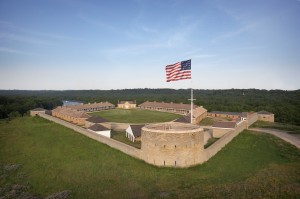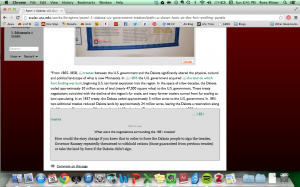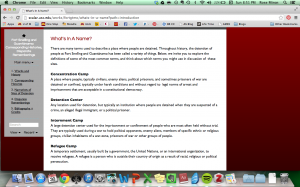Sacrificing comfort for complexity: Presenting difficult narratives in public history
24 April 2014 – Rose Miron
Editor’s Note: This piece continues a series of posts related to the Guantánamo Public Memory Project, a collaboration of public history programs across the country to raise awareness of the long history of the US naval base at Guantánamo Bay (GTMO) and foster dialogue on its future. For an introduction to the series, please see this piece by the Project’s director, Liz Ševčenko.
Upon entering Fort Snelling, visitors are greeted with American flags, interpreters dressed in 19th-century military attire, and a narrative of patriotism and progress. The historic site in St. Paul tells the story of Minnesota’s founding but in the process obscures a story about Dakota dispossession and genocide. For Dakota people, Fort Snelling is not a symbol of the state’s triumphant founding but rather a testament to American imperialism, a reminder of the women and children that were held there in the winter of 1862-1863, and the hundreds that died in the camp, as well as on the death marches to and from Fort Snelling. It is this “difficult history” that the Minnesota Historical Society struggles to present at Fort Snelling.
Public historians are consistently forced to consider how visitors will react to content that disrupts dominant narratives. Audiences often come to historic sites and museums with well-established expectations about the subject matter presented, and as scholar Roger Simon states, history becomes difficult when it “confronts visitors with significant challenges to their museological expectations and interpretive abilities.”[1] When confronting these difficult histories, visitors often become uncomfortable and even shut down, choosing to disengage with or reject the history at hand. Thus, in an effort to avoid alienating audiences, public history institutions often avoid presenting difficult subjects, leaving dominant narratives intact, and fulfilling, rather than challenging, visitor expectations.[2]
While it’s certainly true that visitors should be engaged and not purposefully alienated, at what point are we sacrificing historical complexity and hard truths in order to promote comfort? Instead we should consider the potential within such public institutions to reshape dominant narratives of history, presenting difficult information in such a way that it makes visitors slightly uncomfortable, encouraging them to reconsider their existing knowledge, without causing them to shut down. This was precisely what my colleagues and I aimed for when creating our project, “Fort Snelling and Guantánamo: Corresponding Histories, Disparate Rememberings.”[3]
As a part of the Guantánamo Public Memory Project, our work seeks to put Fort Snelling in conversation with Guantánamo. While generally conceptualized as a site of national military history, Fort Snelling was used as a concentration camp for Dakota people during the winter of 1862-1863, a difficult history that the Minnesota Historical Society (MHS) chooses to de-emphasize within the larger narrative of the site. While MHS has consistently struggled to find effective ways to interpret this history, and has made significant improvements in the past few years, our project asserts that this history of violence should stand at the center of Fort Snelling’s history. Thus, our project seeks to draw on the similar histories of detention at Fort Snelling and Guantánamo, asking why the two sites are remembered so differently today, and what this might tell us about larger narratives of empire and imperialism. By drawing a comparison between Fort Snelling and Guantánamo, we are asking people to bring a critical lens to a beloved site in Minnesota.
In considering the ways we could push visitors to think critically without shutting down, two decisions that we grappled with stand most clearly in my mind. The first involves our critique of the space MHS calls the “Indian Agency,” specifically six large exhibit panels which tell the story of the US-Dakota War. While Fort Snelling is a site that also relies on interpreters who verbally communicate information, these six panels are the only textual representation of Dakota people at the site. To highlight important details that are not included in these panels, part of our project analyzes each of them critically, pointing to events that are left out of these narratives.
Our additions ask visitors to seriously reconsider what they know about Minnesota history. In an earlier version of the project, we annotated the panels with language that some respondents felt was too harsh and directive. In response, some respondents appeared to close themselves off to our entire project. We then tried to find more open-ended and provocative ways to make our points. The goal was to engage skeptical audiences rather than to alienate them. To that end, the final annotation asks questions, encouraging visitors to reach conclusions on their own instead of being told what is right and wrong.
In contrast to this, the second decision we made, this time focused upon vocabulary, likely makes people quite uncomfortable. While those within the Dakota community refer to the detention of Dakota people at Fort Snelling as a concentration camp, MHS has avoided using this language, instead opting to call the detention an “internment camp.” The nature of the camp fits the definition of a concentration camp and calling it such made sense to us. On the other hand, the phrase draws comparisons to Nazi Germany for most people, which is troubling for those who hold fond memories of Fort Snelling.
While we struggled with the decision to include potentially polarizing language in our project, we ultimately opted to use “concentration camp” to describe the detention of Dakota people but also provide a definition of the phrase.[4] While accepting the risk that this may alienate some visitors, we felt that calling the concentration camp by another name was a disservice to the memory of those Dakota people who died. While we were willing to make some changes to make viewers more comfortable, we wanted visitors to notice the stark difference in how Fort Snelling and Guantánamo are remembered in spite of their similar histories. To make this point, we felt visitors had to feel some uneasiness in that difference.
When making decisions about sensitive subjects in public history, we as public historians are always taking a risk that visitors will shut down, dismiss our work as biased, and never return. Yet when working within a public institution, we must consider the incredible potential we have to shape narratives of history and the responsibility we have to present a narrative that we believe to be most accurate. Indeed, Roger Simon tells us that museums are “institutions of memory with a potential public role in constituting what members of any given society understand as their cultural heritage.”[5] Thus, we should consider what can be accomplished by making these difficult histories public. By placing these counter-narratives within an institution that is lauded as a place of knowledge, what potential do we have to change the way Minnesotans conceptualize Fort Snelling? As noted by Dakota scholar Waziyatawin, it is necessary to “disallow Minnesotans from denying or ignoring the history of genocide and the perpetuation of human injustices.”[6] It is only by acknowledging these injustices that we can create an atmosphere for restorative justice. As public historians, it is our responsibility to present difficult histories that can aid in creating such an atmosphere.
~Rose Miron is a PhD student at the University of Minnesota in the Department of American Studies.
[1] Roger I. Simon, “A Shock to Thought: Curatorial Judgement and the Public Exhibition of ‘Difficult Knowledge’,” Memory Studies 4 (February 2011): 433.
[2] While I’m relying heavily on Simon in this piece, I also draw on the work of other scholars who consider difficult history, such as James Oliver Horton and Lois Horton (Slavery and Public History: The Tough Stuff of American Memory), Amy Tyson (The Wages of History: Emotional Labor on Public History’s Front Lines), Bain Attwood (“Difficult Histories: The Museums of New Zealand Te Papa Tongarewa and the Treaty of Waitangi Exhibit”), and Richard Handler and Eric Gable (The New History in an Old Museum: Creating the Past at Colonial Williamsburg)
[4] The definition of concentration camp we use is an adaptation from various online dictionaries and sites, including the US Holocaust Museum. We pulled what we considered common details from each of these sources to craft a general definition of “concentration camp.”
[5] Ibid., 432.
[6] Waziyatawin, What Does Justice Look Like?: The Struggle for Liberation in Dakota Homeland. (St. Paul: Living Justice Press, 2008), 11.






